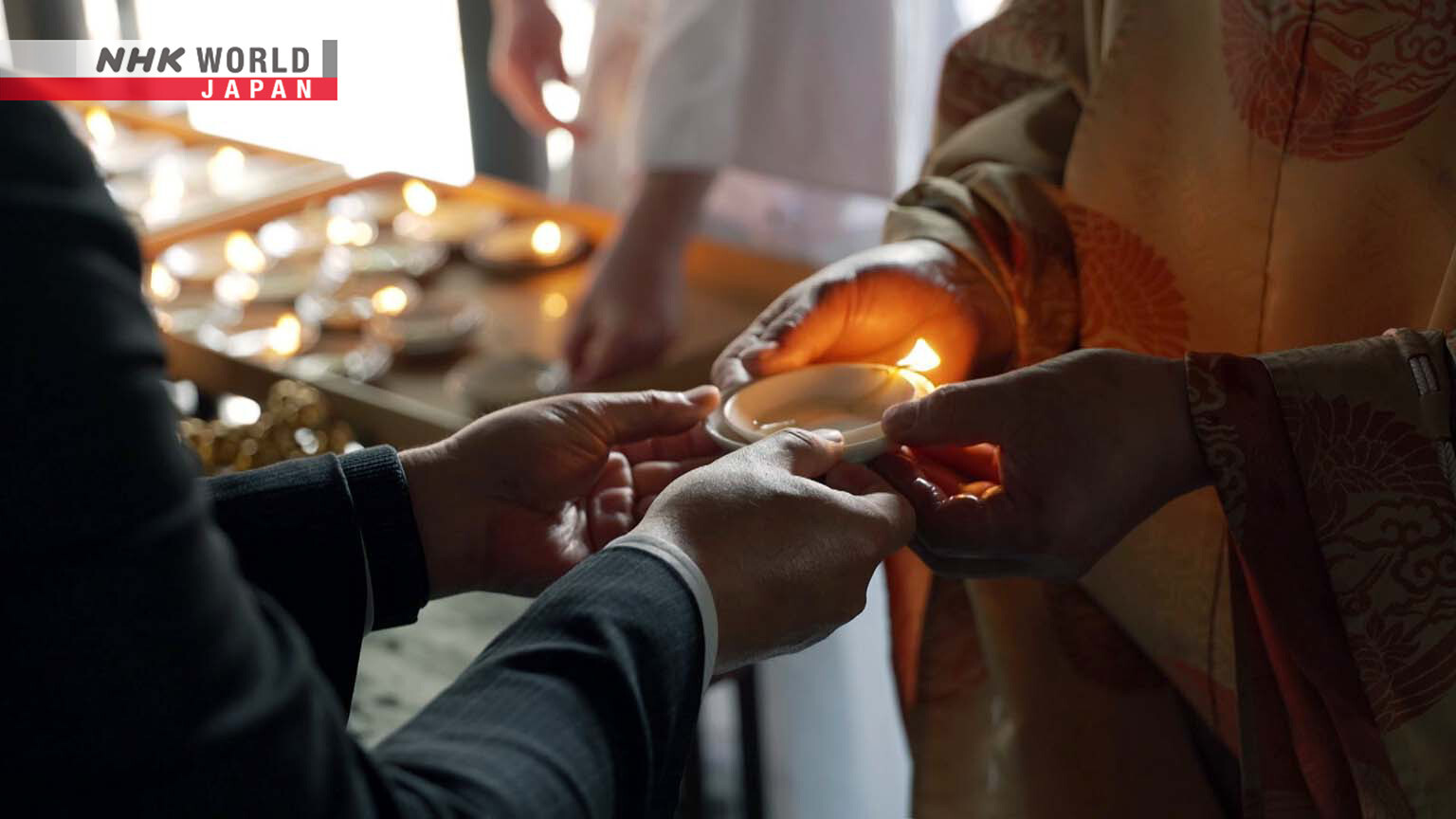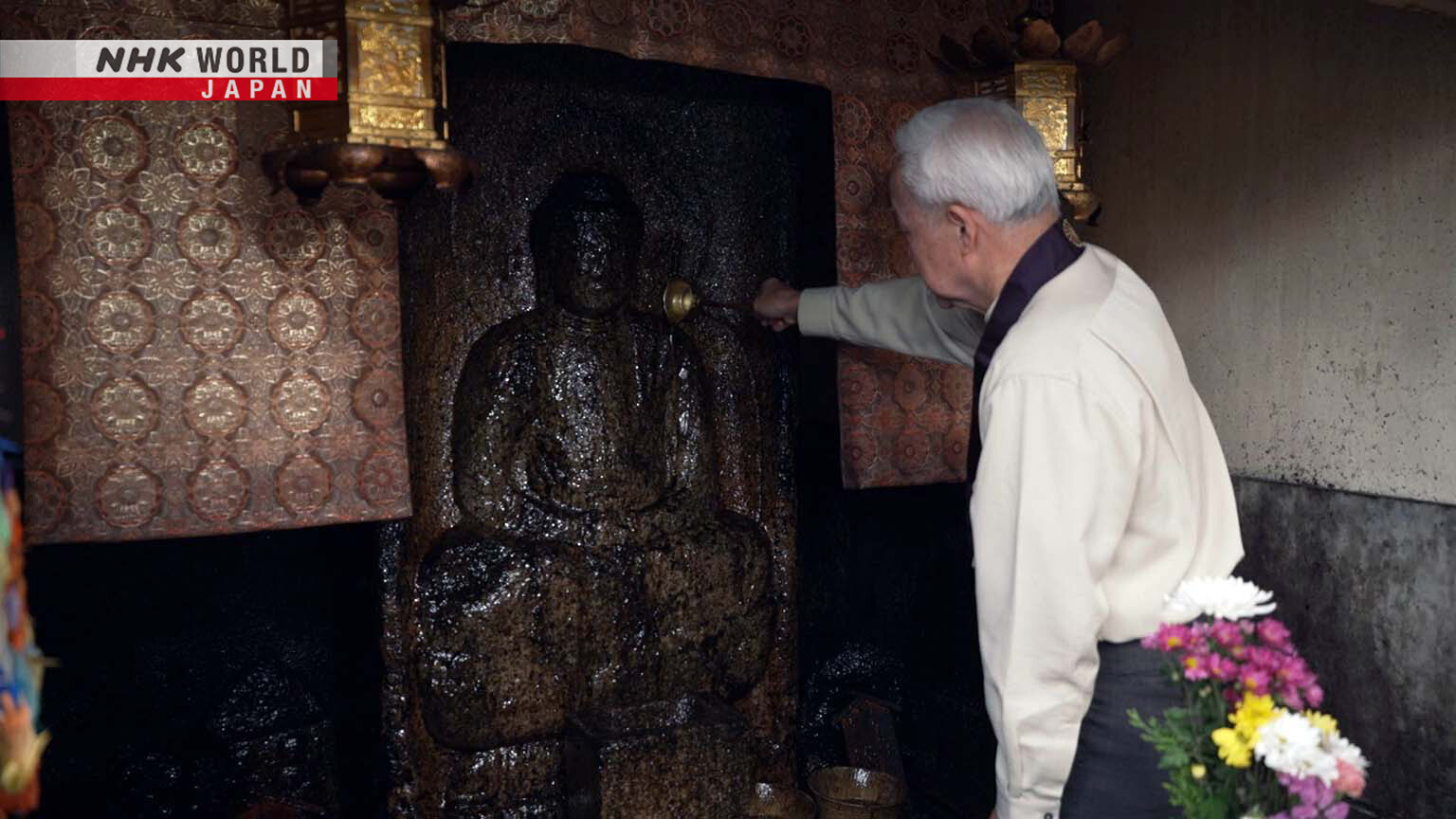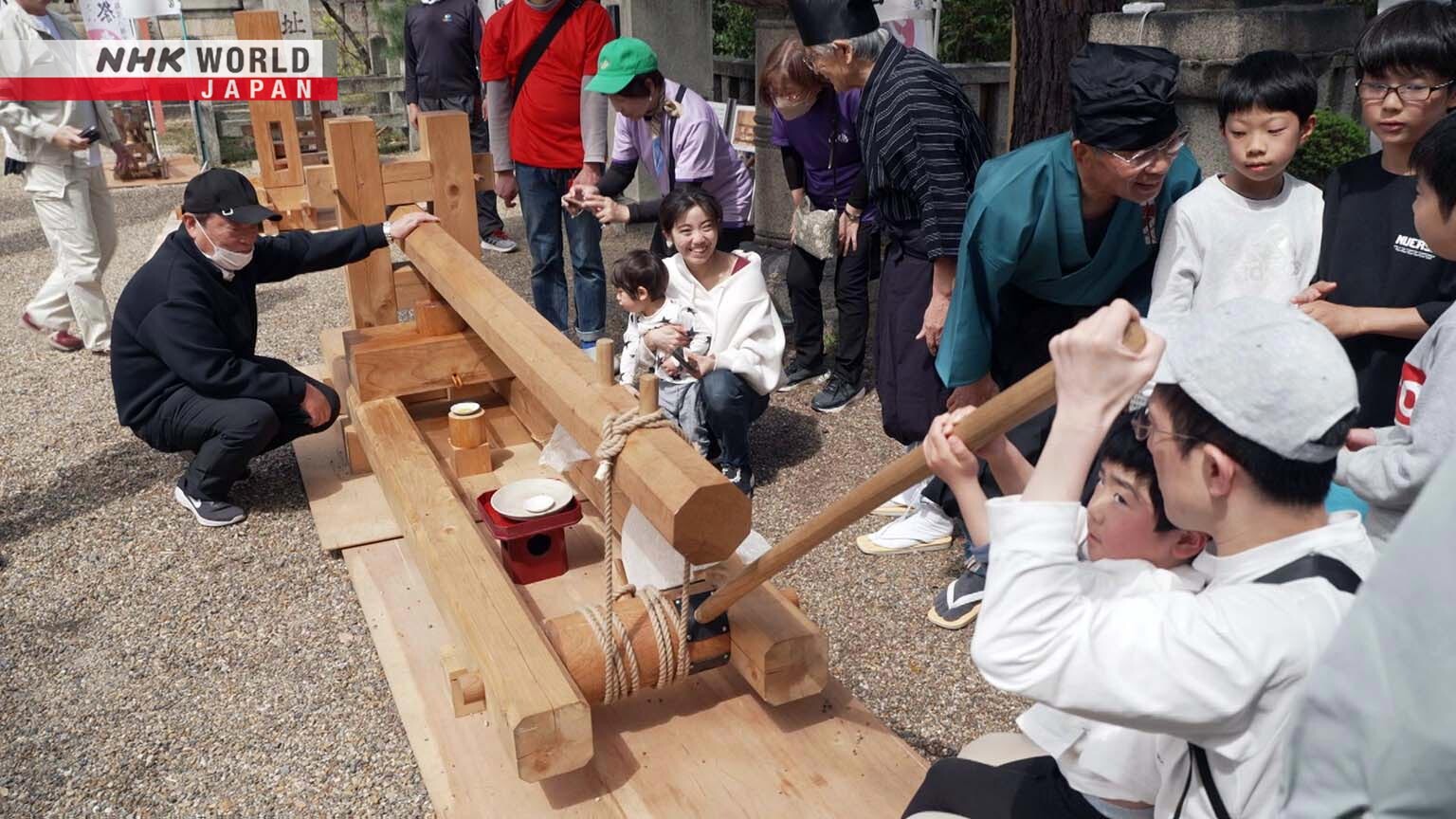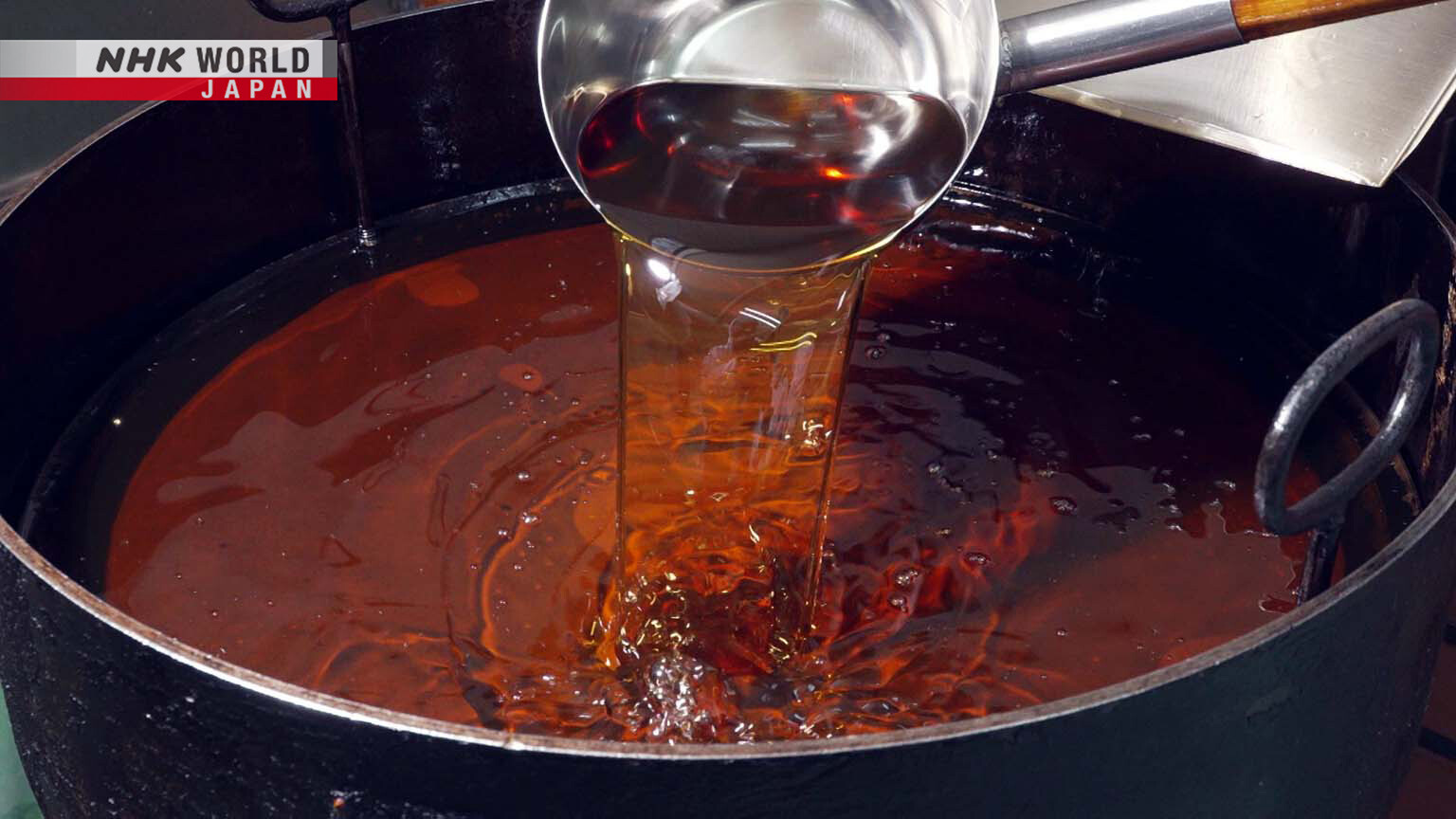Versatile Oil: Smoothing the Way in Everyday Life
Kyoto dominated the oil market 1,000 years ago. Various oils fueled votive lamps, flavored food, preserved wood, and were used in pomade and cosmetics. Oil still plays a key role in the culture today.




Transcript
Droplets of rich gold.
The finest oil, freshly pressed.
It is an exacting process conducted by craftsmen with dedicated drive.
To exaggerate a bit, the flavor flips within seconds, so that judgment is difficult.
Oil was originally used in votive candles lit for Buddhist and Shinto deities.
Candles illuminated dark nights in the capital of Kyoto for over a millennium.
Oil guilds were established in regions throughout the country.
Communities today still demonstrate pride in the traditions they inherited.
You did it. Oil is coming out.
I'd like everybody to know about the strengths and history of "egoma" oil.
Oil has been integral to Japanese lifestyles in numerous ways.
Tracing its history leads to insight into its unique legacy in Kyoto.
Core Kyoto discovers how drops of oil have smoothed the way in the ancient capital over the centuries.
This wholesaler has specialized in oils for some two centuries.
Here you see all sorts of popular cooking oils.
We have everything from rapeseed and corn to sesame, peanut, and rice oils.
Camellia oil is said to enhance the beauty of skin and hair.
To keep their long black hair beautiful, women in the Heian imperial court
removed dirt and dandruff by applying camellia oil with a boxwood comb.
Although oil serves a myriad of purposes today, historically it was used primarily for illumination.
You could buy about 1 liter of oil with 2 liters of sake, so oil was double the price of sake.
It was valuable and expensive.
Oil additionally helped preserve buildings.
This century-old machiya townhouse is undergoing renovation.
Wooden lattices and exterior walls are primed with a mixture of persimmon tannin and iron oxide pigment
to guard against insects and rot.
Two coats of the primer are applied, and a coat of oil is the finishing touch.
It is extracted from the seeds of a perilla plant variation.
Called "egoma" in Japanese, it is a member of the mint family and similar to "shiso."
This repels water and shields the wood in places exposed to rain.
It is indispensable in protecting homes.
Egoma oil has long been used for waterproofing,
as it creates a hard, water-resistant film when applied over wood.
The oil also enhances the wood's appearance over time.
Paint deteriorates over time, but "egoma" oil penetrates the wood.
When applied repeatedly then dry wiped, it produces a shine.
This century-old building shows how the oil protects -
and proves that it is both precious and invaluable.
On a street in western Kyoto, a small temple watches over passers-by.
A shiny black stone Buddha sits within.
Visitors here have a unique way of paying their respects.
They pour oil over the statue.
Created some 800 years ago, this image of Amida Buddha is locally known as Aburakake Jizo, or oil-dowsed Jizo.
Long ago, oil merchants delivered their commodity to residents in vats balanced on poles over their shoulders.
This traffic route was popular with those merchants.
When they passed by, they would pause to pour oil over the Buddha.
Oil was extraordinarily expensive.
It required a great commitment to spare some to pour over the statue -
so people partnered that gesture with an equally meaningful wish.
Worshippers came to believe that sacrificing precious oil would surely result in their prayers being fulfilled -
a local belief that has lasted centuries.
Mt. Tenno stands in southwestern Kyoto, with the town of Oyamazaki nestled in its foothills.
Rikyu Hachimangu, a local Shinto shrine, is said to be the birthplace of Japan's oil production.
It offers customary amulets as well as "an oil talisman" not found elsewhere.
This says "sacred oil" as this locale is known as the birthplace of oil production.
This is sacred "egoma" oil.
The tie between the shrine and oil is historically documented.
Roughly a millennium ago -
a Rikyu Hachimangu priest apparently invented this oil press.
That invention spurred recognition of Oyamazaki as the birthplace of oil production.
The mechanism works on the principle of leverage
and in its day enabled the more efficient extraction of larger quantities of oil from "egoma" seeds.
Oyamazaki thus became known as a major production hub of "egoma" oil used for lighting.
Priests at Rikyu Hachimangu formed an association to oversee the oil production.
The ruling shogun granted Oyamazaki exclusive rights to purvey the oil,
enabling expansion of the community's trade area.
Wealth garnered from oil enabled Oyamazaki to prosper.
The annual Hinoto Festival is held here during the cherry blossom season.
The day is set aside to show gratitude to the deity of oil.
Representatives of around 80 oil-focused businesses gather from across the nation.
The festival expresses hope for continued peace through the blessings of oil.
Solemn prayers are offered with oil candles.
We hope to ensure the future of this long history.
All of us, manufacturers and wholesalers alike, choose to gather in service and dedication.
This is a special place for us in the oil industry.
Cans of oil donated by industry members are displayed before the shrine during the Hinoto Festival.
A worshipper solemnly accepts a can of oil offered in dedication.
We use the sacred oil offered to Hachimangu to make tempura, our specialty.
The chef's restaurant is located adjacent to the shrine.
He pours the consecrated oil into the pot to prepare his signature dish.
Since the deity of oil is enshrined here, the town decided to make oil its specialty.
We use the oil offered to the deity to create our signature tempura.
Seasonal ingredients are deep fried in hopes that the oil deity will bless those who consume them.
It is important to treat this oil with care as it was dedicated to the deity.
I hope more people will know of Oyamazaki and the goodness of this oil.
The morning of the Hinoto Festival.
A large wooden apparatus is being removed from the storehouse.
It is a modern replica of the invention which brought fame to Oyamazaki - an oil press known as the "nagaki."
They use it to demonstrate oil extraction during the festival.
The Oyamazaki Egoma Club sponsors the event.
The group - formed a decade ago - promotes the history and culture of the "oil town"
and holds activities highlighting "egoma" oil.
History is becoming increasingly obsolete -
and even the old-timers have difficulty recalling how things developed.
We created the club to counter this and pass information on to the next generation.
One initiative was the revival of the "nagaki."
A construction company dealing with shrines, temples, and other traditional wooden buildings
used old drawings kept at Rikyu Hachimangu to create it.
You must use an apparatus to understand how it works. Drawings are not enough.
We had people try the replica, and then made adjustments.
- We changed this part.
- Yes, the wood cracked.
So we tried another material and made changes.
We're honored by the valuable experience of recreating something historical.
Sugito and other members dress up like oil merchants in homemade costumes to liven up the event.
We want an old-time atmosphere.
I feel like the real thing.
Local children play a major role in extracting the oil.
The "egoma" seeds used in the event were grown and harvested by the children the previous year.
The Egoma Club members visit the local elementary school to instruct the children in "egoma" cultivation.
Fourth-grade students participate annually to better understand their community.
The important thing is for children to gain a better understanding.
I work with them in summer, getting dirty and sweaty, watering and harvesting.
I've been doing it for a while, so now children see me and say, "That's the 'egoma' man."
"Egoma" is becoming increasingly well-known in Oyamazaki.
It was tough, but we worked hard to raise the plants, so it was worth it.
The children harvest the round "egoma" seeds in October and dry them for the festival.
They rotate the handle to tighten the rope and use that leverage to squeeze out the oil.
You did it. Oil is coming out.
The oil symbolizes the thoughts and hopes of the Egoma Club and the local children.
The freshly pressed oil is presented as an offering to the deity.
It was amazing to see such a tiny thing turn into oil.
"Egoma" has a lot of history, so I hope more people will learn about it.
If the children recall sowing the seeds and the harvest when they're older -
I hope the memory will gladden their hearts.
In the "oil town" of Oyamazaki, the flames of hometown pride burn bright.
The quiet residential area of Katsura, which lies north of Oyamazaki,
is home to a company which has been producing and selling sesame oil for the past 90 years.
It's the aroma.
Japanese appreciate the aroma of sesame -
and the sesame oil we produce exudes a fine aroma.
Artisans painstakingly produce the oil without additives.
Their commitment is of course appreciated in Kyoto,
but shops in France, Germany, and other countries are increasingly handling the product.
Yamada Yutaka founded the company to produce sesame oil that would meet his own expectations.
My grandfather was physically weak and became stronger with health counseling.
When he recovered his health, he thanked the counselor -
who insisted that my grandfather make food to help others instead of thanking him.
And our sesame oil was born.
He wanted to produce food for others that he himself found delicious and safe.
Today, Yamada produces sesame oil using the same production method his grandfather and father did.
His factory, located in Hiyoshi, Nantan, is a 50-minute drive from the head office in Kyoto city.
Sesame seeds are imported from several countries,
but those used to produce the finest sesame oil are golden sesame seeds from Turkey.
They are rich in oil which is particularly aromatic when extracted.
The first step involves roasting the seeds in a large iron pot.
We roast about 40 kilograms of sesame seeds for 20 to 25 minutes.
During the final minute or so, the oil produces a rich aroma.
But if you roast the seeds for too long, they burn, and the oil becomes bitter.
To exaggerate a bit, the flavor flips within seconds, so that judgment is difficult.
They engage all five senses and are guided by the color of the seeds,
the feel when crushed, and the aroma of the rising steam.
There is no manual; experience is the key.
It's a big responsibility and involves hard work.
Water is added with precision timing, moments before the roasting is done.
Steaming the seeds like this expedites the extraction.
The roasted seeds are then transferred to be squeezed under pressure.
The seeds are usually pressed three times, but Yamada only uses what emerges from the first press.
We only want the tastiest oil, and the second and third presses produce a bitter taste.
From a profit standpoint, we should be pressing more -
but flavor is most important to us.
The first pressed oil is left to stand for a full day, then hot water is added and the mixture is stirred.
The product is sealed and refrigerated for about three weeks.
Water, which has a higher density than oil, precipitates at the bottom with any impurities,
leaving only the umami flavor in the oil.
Refining is the last step in the process.
The top layer of the aged oil is drawn off and heated in a wood-fired stove
to allow the evaporation of any remaining moisture.
The artisan's experience, skill, and persistence merge into the creation of a Kyoto sesame oil.
Delicious.
- How is it?
- It’s delicious. Great flavor.
Whenever I see that golden color, I feel so delighted by how far we have come.
After Yamada graduated from college, he took a job with a major food manufacturer and the family business closed.
However, he began to question the way things were being done.
They were using cheap raw materials and many additives, no doubt to keep costs down.
The trend to make more profit, no matter what, gave me second thoughts.
My grandfather served everyone by producing sesame oil without any questionable elements.
He made me realize that health and happiness should be top priority.
So I quit the company after 4 years and 9 months,
and relaunched our family business in 1989.
That first year, sales only reached 370,000 yen - around 2,700 US dollars at the time.
It was nothing but hard work,
but eventually, people began to appreciate Yamada's tradition-based approach to manufacturing a safe product.
And, more stores carried his oil.
Keeping his grandfather close in his heart,
Yamada is committed to a people-oriented business and does what he can to contribute to society.
He holds family workshops and cooking classes,
promoting the importance of good eating habits to the young generation.
He has also turned his attention to the issue of food loss.
These treats are made from sesame seed pomace, left over after the oil is pressed.
It doesn't serve humanity to discard something which could be used.
The oil pomace also helps sustain local products.
This well-maintained bamboo grove stands in Nagaokakyo, just west of Kyoto.
Spring is the season for bamboo shoots, a noted local delicacy.
I brought oil pomace.
Yamada visits Ishida Masaji, a bamboo shoot farmer he has known for around a decade.
Ishida uses Yamada's sesame oil pomace as fertilizer.
In the past, this residual product would have been discarded.
You'd think you could eat this, based on its fine aroma.
Ishida uses a special tool to dig up bamboo shoots before they emerge from the ground and harden.
He then fills the resulting holes with fermented oil pomace fertilizer.
We call this "gratitude fertilizer" and use it to show appreciation for the bountiful harvest.
The fertilizer cannot be absorbed on the surface,
so we put it in the holes to benefit the underground stems.
The oil pomace completely changes the bamboo's flavor.
Since Yamada's manufacturing method only uses the first press,
ample oil remains in the pomace to produce a nutrient-rich fertilizer.
It's like pouring dashi broth over the growing bamboo.
Just as chefs have different uses for differing types of kelp -
it makes sense to use good fertilizer to grow quality bamboo shoots.
You once found bamboo groves everywhere, but they are swiftly disappearing.
We must preserve such Kyoto landscapes. I'd like to do my part to help.
We need to make sure we leave some nutrition in the pomace.
Kyotoites take pride in the culture that evolved over centuries around oil,
and it continues to be handed down to younger generations.
Each golden droplet reflects both tradition and renewal.